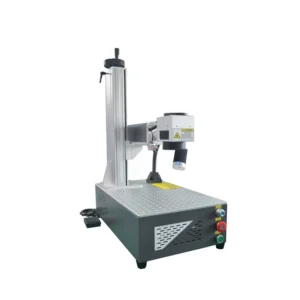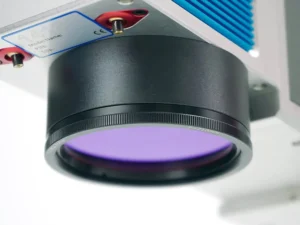Introduction:
Laser marking can turn your idea into reality. This technology is always an accurate and effective option. When you deal with another method, you will find limitations with accuracy. In contrast, laser marking can achieve up to 0.001 mm. Fiber and CO2 Laser are two familiar laser sources used in laser marking. To choose the correct method, you must know what makes them different: “CO2 VS Fiber Laser .”
This article highlights the significant difference between CO2 laser and fiber laser. It uses some key factors to distinguish between the two methods. Later, it justifies which is better: CO2 or Fiber Laser.
What is a CO2 Laser Marking Machine?
Laser marking refers to the printing or etching using a focused laser beam. The CO2 laser is one of the popular types of laser beam. Its wavelength is around 10.6 micrometers. Using this beam, you can mark, engrave, or cut any materials, from paper to metal. The CO2 laser marking machine is accurate and fast.
A CO2 laser marking machine generates a CO2 laser from a glass tube filled with a gas mixture. As this implies, this glass predominately contains carbon dioxide gas. The machine first applies a high voltage through the tube. Note that the glass tube is completely sealed.
The high-voltage current reacts with the gas particles. Each particle gains energy and goes to an excited state, emitting light. This light is further amplified, resulting in a CO2 laser. This is how the CO2 laser marking machine works.
CO2 laser machines are versatile. You can use this machine to mark on a wide range of materials. Many industries now prefer CO2 laser machines to mark product names and serials. The CO2 laser is suitable for non-metals. Therefore, it is used in the packaging, electronics, and textile industries. Besides, the CO2 laser marking machine is also ideal for making many home décor items.
Benefits of CO2 Laser Marking Machine
- CO2 laser marking machine produces accurate markings. You can create complex designs using various materials.
- The marking speed is faster than other mechanical methods.
- A CO2 laser marking machine is famous for non-metals, like wood, plastics, and cloth.
- The marks produced by the CO2 laser are permanent and resistant to wear, heat, and chemicals.
Limitations of CO2 Laser Marking Machine
- The CO2 laser marking machine is not suitable for metals. Fiber laser marking machine works best for metals. The main reason behind this is its wavelength. As you know, the CO2 laser wavelength is 10.6 micrometers. Metals can not efficiently absorb this wavelength.
- CO2 laser marking machines offer less durability than fiber laser marking machines. Typically, they last two years, but fiber lasers last over three years.
- The operation cost is high since you will need to purchase consumables.
- CO2 laser machines need more maintenance than fiber laser marking machines.
What is a Fiber Laser Marking Machine?
A fiber laser marking machine uses fiber lasers. Similar to CO2 lasers, its main purpose is to mark or etch on various materials. The marks are permanent and durable. Fiber laser wavelength typically ranges from 0.78 to 2.2 micrometers. It is highly accurate. Using it, you can etch complex designs, barcodes, logos, and texts.

A fiber laser marking machine generates fiber lasers from diodes. These diodes send the laser into the fiber-optic cable. The pump combiner combines all these beams to create high-power lasers. Later, based on different fiber lasers, these lasers are further amplified. Finally, it reaches the laser gun to mark, engrave, or cut various materials.
Fiber laser marking machines are more popular than CO2 laser marking machines. They are versatile for all types of materials. Fiber laser marking machines are widely used to mark products and enthusiast items. In manufacturing, you may often find its use. This is needed for metal parts, tools, packaging, containers, and electronics.
Benefits of Fiber Laser Marking Machine
- Fiber laser marking is more accurate than CO2 laser marking. Their small wavelength can create high energy density in a small area. CO2 lasers comparatively create a wider area. As a result, fiber lasers are more accurate, even for highly complex designs.
- This laser marking machine is especially suitable for metals. Because of this, fiber lasers are widely used in many metal part factories.
- Fiber laser machines need low maintenance.
- This device is more durable than CO2 laser machines, typically more than three years.
Limitations of Fiber Laser Marking Machine
Fiber laser marking machines may not provide good results on non-metals. As you know, the fiber wavelength remains in a smaller area. It typically exceeds the non-metal absorption range. A CO2 laser machine is always preferred for cutting non-metals.
What Is The Difference Between CO2 And Fiber Laser Marking Machine?
Both fiber and CO2 lasers have unique benefits and limitations from a business point of view. For example, CO2 lasers are suitable for non-metals, while fiber lasers are for metals. On average, both offer good quality when laser marking. There are other differences as well. This section mainly highlights the difference between fiber and CO2 lasers.
CO2 VS Fiber Laser Marking Machine: Accuracy
Fiber lasers have a shorter wavelength, ranging from 0.78 to 2.2 micrometers. On the other hand, CO2 lasers have a wider wavelength, 10.6 micrometers. This difference in wavelength generally impacts their accuracy.

Fiber lasers produce narrow energy density, while CO2 lasers create wider. As a result, fiber lasers can make more precise and detailed markings. Fiber lasers can offer tolerances up to 0.003 inches when engraving, while CO2 lasers offer 0.005 inches. Clearly, fiber lasers provide the most accurate result.
In business, accuracy matters a lot. People often like complex designs. In this case, fiber laser is the preferred choice. However, the accuracy difference between CO2 and fiber laser is only 0.002 inches.
CO2 VS Fiber Laser Marking Machine: Material Selection
CO2 and fiber lasers significantly differ in material compatibility. Fiber lasers make smaller wavelengths, which leads to narrow energy density. Metals can easily absorb this. However, non-metals may struggle with that. The laser creates wider burn marks around the marked area when they can’t absorb it correctly. In laser terms, it is called HAZ or heat-affected zones. It hampers the quality and aesthetics of the marking.
On the other hand, a CO2 laser makes fat wavelengths, which leads to less energy density. This type of laser doesn’t work well on metals, but it might be a better option for non-metals. Wood, leather, and paper are suitable materials for the CO2 laser.
In business, material is one of the most critical parameters. For example, a metal part factory won’t do wood engraving. Therefore, its best choice would be a fiber laser marking machine. On the other hand, textile industries should choose a CO2 laser marking machine.
CO2 VS Fiber Laser Marking Machine: Power Consumption
Power consumption is another vital factor to consider. You should know the photoelectric conversion rate to differentiate between CO2 and fiber laser. It is the rate at which laser beams convert from a unit of electric power.
For example, fiber laser marking machines offer 35% to 50% PE conversion rates. A 20W fiber laser marking machine needs 40 to 57 watts of power.
In contrast, CO2 laser marking machines have a lower PE conversion rate. They offer PE rates from 10 to 15%. Therefore, a 20W CO2 laser marking machine needs 133 to 200 watts of power.
Fiber lasers are generally more efficient. They save power costs. The power consumption rate in the USA is 16.88 cents for 1 KW/h; in the UK, it is 24.50 pence. So, fiber lasers can save a significant amount of money only on power consumption.
CO2 VS Fiber Laser Marking Machine: Service Life
In business, the machine’s working life is very important. It influences your investment and total returns.
Usually, a fiber laser marking machine provides three years of service life. In contrast, the CO2 laser marking machine lasts two years.

CO2 VS Fiber Laser Marking Machine: Complexity & Maintenance Needs
CO2 laser marking machines are complex. However, fiber laser marking machines have a simpler structure. It uses multiple diodes to create the laser beams. Then, the optical fiber and pump combine and pass them to the laser gun.
Because of its complexity, the CO2 laser marking machine needs more maintenance than fiber lasers. It also requires replacing the CO2 laser tubes. On the other hand, fiber lasers are low-maintenance. Once you purchase one, you don’t have to worry about replacements. This not only saves time but also replacement costs.
CO2 VS Fiber Laser Marking Machine: Cost
The CO2 laser marking machine is much cheaper when bought. However, the other expenses generally increase the TOC (Total Ownership Cost).
(1) It needs more energy costs. (2) It needs more upkeep and replacements.
In contrast, a fiber laser marking machine is much more expensive. However, it requires less energy and upkeep. You don’t have to worry about having frequent replacements. Thus, it is a cost-effective solution.
Fiber or CO2 Laser: Which is Better?
Let’s wrap everything up! You learned how CO2 and fiber laser marking machines differ from the above few sections. The following table summarizes the above contents and justifies which might be better for your project.
| Criteria | Fiber Laser | CO2 Laser | Which is Better? |
| Purchase Cost | High | Low | CO2 Laser |
| Operating Cost | Low | High | Fiber Laser |
| Material Compatibility | Metals and some plastics | Non-metals | Depends on the type of application |
| Energy Consumption | Low | High | Fiber Laser |
| Lifespan | Longer | Shorter | Fiber Laser |
| Precision | Higher | Lower | Fiber Laser |
| Maintenance | Low | High | Fiber Laser |
